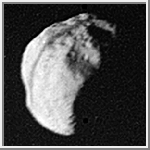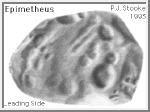















|
Epimetheus [ep-eh-MEE-thee-us] is the fifth satellite of Saturn. It was discovered by R. Walker in 1980. Epimetheus was the son of Iapetus and brother to Prometheus and Atlas. Epimetheus means hindsight in Greek. It has an irregular shape with a size of 144x108x98 kilometers (89x67x61 miles) in diameter. It is traversed by several large and small grooves, valleys and ridges. Several craters larger than 30 km can be seen on its surface. The pervasive cratering indicates that its surface must be several billion years old. The above image shows the shadow of Saturn's F Ring crossing its surface.
Epimetheus and Janus share the same orbit of 151,472 kilometers from Saturn's center or 91,000 kilometers above the cloud tops. They are only separated by about 50 kilometers. As these two satellites approach each other they exchange a little momentum and trade orbits; the inner satellite becomes the outer and the outer moves to the inner position. This exchange happens about once every four years. Janus and Epimetheus may have formed from a disruption of a single parent to form co-orbital satellites. If this is the case, the disruption must have happened early in the history of the satellite system.
| Views of Epimetheus |
|---|
 Epimetheus
Epimetheus
This image of Epimetheus was acquired by the
Voyager 1 spacecraft on November 11, 1980.
(Credit: Calvin J. Hamilton)
 Topographic Map of Epimetheus
Topographic Map of Epimetheus
This is a topographic map of Epimetheus. It is based upon the shape model of Phil
Stooke. As with all maps, it is the cartographer's interpretation;
not all features are necessarily certain given the limited data
available. This interpretation stretches the data as far as possible.
(Courtesy A. Tayfun Oner)
 Conformal Projection of Epimetheus
Conformal Projection of Epimetheus
This image is a shaded relief map of Epimetheus, the smaller co-orbital
satellite of Saturn. As with all maps, it is the cartographer's
interpretation and not all features are necessarily certain given the
limited data available. This interpretation stretches the data as far as
is feasible.
This image shows two different views of Epimetheus in a Morphographic
Conformal Projection. One view shows the
leading side and the
other the trailing side.
(Courtesy Phil Stooke, NSSDC, and NASA)
| References |
|---|
Stooke, P. J., "The Topography of Epimetheus," Earth, Moon and Planets, 63 (1993), 67-83.
Copyright © 1997 by Calvin J. Hamilton. All rights reserved.